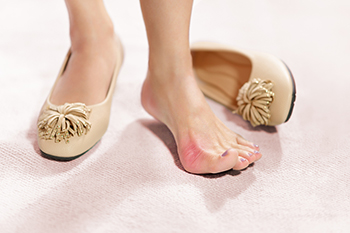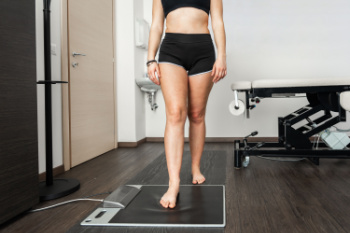
 An ingrown toenail occurs when the edge of a toenail grows into the surrounding skin, causing pain and swelling. This often happens due to improper nail trimming, wearing tight shoes, or having naturally curved nails. When the toenail pierces the skin, it can create an entry point for bacteria, leading to an infection. Signs of an infected ingrown toenail can include redness, swelling, warmth, and pus. If the infection is not treated, it can worsen, leading to severe pain, increased swelling, and potentially serious complications such as spreading the infection or a bone infection. To treat an ingrown toenail infection, start by soaking the affected foot in warm, soapy water several times a day to reduce swelling and relieve discomfort. After soaking, apply an antibiotic ointment and cover the area with a clean bandage. Avoid wearing tight shoes and opt for open-toed footwear to reduce pressure on the toe. If the infection persists or worsens, it is suggested that you schedule an appointment with a podiatrist who can provide proper treatment, which may include minor procedures to remove part of the nail and prevent further issues.
An ingrown toenail occurs when the edge of a toenail grows into the surrounding skin, causing pain and swelling. This often happens due to improper nail trimming, wearing tight shoes, or having naturally curved nails. When the toenail pierces the skin, it can create an entry point for bacteria, leading to an infection. Signs of an infected ingrown toenail can include redness, swelling, warmth, and pus. If the infection is not treated, it can worsen, leading to severe pain, increased swelling, and potentially serious complications such as spreading the infection or a bone infection. To treat an ingrown toenail infection, start by soaking the affected foot in warm, soapy water several times a day to reduce swelling and relieve discomfort. After soaking, apply an antibiotic ointment and cover the area with a clean bandage. Avoid wearing tight shoes and opt for open-toed footwear to reduce pressure on the toe. If the infection persists or worsens, it is suggested that you schedule an appointment with a podiatrist who can provide proper treatment, which may include minor procedures to remove part of the nail and prevent further issues.
Ingrown toenails may initially present themselves as a minor discomfort, but they may progress into an infection in the skin without proper treatment. For more information about ingrown toenails, contact Dr. Thomas Tran of Southwestern Foot & Ankle Associates, P.C.. Our doctor can provide the care you need to keep you pain-free and on your feet.
Ingrown Toenails
Ingrown toenails are caused when the corner or side of a toenail grows into the soft flesh surrounding it. They often result in redness, swelling, pain, and in some cases, infection. This condition typically affects the big toe and may recur if it is not treated properly.
Causes
You are more likely to develop an ingrown toenail if you are obese, have diabetes, arthritis, or have any fungal infection in your nails. Additionally, people who have foot or toe deformities are at a higher risk of developing an ingrown toenail.
Symptoms
Some symptoms of ingrown toenails are redness, swelling, and pain. In rare cases, there may be a yellowish drainage coming from the nail.
Treatment
Ignoring an ingrown toenail can have serious complications. Infections of the nail border can progress to a deeper soft-tissue infection, which can then turn into a bone infection. You should always speak with your podiatrist if you suspect you have an ingrown toenail, especially if you have diabetes or poor circulation.
If you have any questions, please feel free to contact our office located in Frisco, TX . We offer the newest diagnostic and treatment technologies for all your foot care needs.

Bunions, or hallux valgus, disproportionately affect women, significantly impacting their overall foot health. Women are particularly susceptible due to factors like frequent wearing of high-heeled or narrow shoes, along with genetic predispositions. The risk of bunions has been shown to increase with age. The formation of a bunion starts with the big toe bending toward the smaller toes, which leads to a painful bony protrusion on the side of the foot. As bunions progress, they disrupt the alignment and function of adjacent toes. This often leads to formation of hammertoes or claw toes, altered weight distribution, corns and calluses. Research suggests that the severity of bunions correlates with increased pain not only in the feet but also in other parts of the body. Family history and flat feet are other contributing factors to the development of bunions. Addressing bunion deformity through early and effective interventions can offer significant relief and improve overall quality of life. If you are experiencing bunion-related discomfort, it is suggested that you make an appointment with a podiatrist for an exam and treatment.
If you are suffering from bunion pain, contact Dr. Thomas Tran of Southwestern Foot & Ankle Associates, P.C.. Our doctor can provide the care you need to keep you pain-free and on your feet.
What Is a Bunion?
Bunions are painful bony bumps that usually develop on the inside of the foot at the joint of the big toe. As the deformity increases over time, it may become painful to walk and wear shoes. Women are more likely to exacerbate existing bunions since they often wear tight, narrow shoes that shift their toes together. Bunion pain can be relieved by wearing wider shoes with enough room for the toes.
Causes
Symptoms
In order to diagnose your bunion, your podiatrist may ask about your medical history, symptoms, and general health. Your doctor might also order an x-ray to take a closer look at your feet. Nonsurgical treatment options include orthotics, padding, icing, changes in footwear, and medication. If nonsurgical treatments don’t alleviate your bunion pain, surgery may be necessary.
If you have any questions, please feel free to contact our office located in Frisco, TX . We offer the newest diagnostic and treatment technologies for all your foot care needs.

The human foot is a marvel of engineering, comprising a complex interplay of bones, muscles, ligaments, and blood vessels that work seamlessly to support our weight, absorb shock, and propel us forward. At the heart of this structure lies the arch, which acts as a natural shock absorber, distributing forces evenly as we walk, run, or stand. Supporting the arch are muscles and ligaments that form a dynamic system, constantly adjusting to maintain balance and stability. Meanwhile, the toes play a vital role in balance and propelling us forward, while gripping the ground with each step and helping us navigate uneven terrain. Beneath the surface, a network of blood vessels ensures adequate oxygen and nutrients reach the tissues, supporting their function and repair. Foot pain can happen for a variety of reasons, and it may be connected to a mishap or a foot deformity. If you have foot pain for any reason, it is suggested that you visit a podiatrist who is an expert in treating such conditions.
If you have any concerns about your feet, contact Dr. Thomas Tran from Southwestern Foot & Ankle Associates, P.C.. Our doctor can provide the care you need to keep you pain-free and on your feet.
Biomechanics in Podiatry
Podiatric biomechanics is a particular sector of specialty podiatry with licensed practitioners who are trained to diagnose and treat conditions affecting the foot, ankle and lower leg. Biomechanics deals with the forces that act against the body, causing an interference with the biological structures. It focuses on the movement of the ankle, the foot and the forces that interact with them.
A History of Biomechanics
Modern technological improvements are based on past theories and therapeutic processes that provide a better understanding of podiatric concepts for biomechanics. Computers can provide accurate information about the forces and patterns of the feet and lower legs.
Understanding biomechanics of the feet can help improve and eliminate pain, stopping further stress to the foot.
If you have any questions please feel free to contact our office located in Frisco, TX . We offer the newest diagnostic and treatment technologies for all your foot and ankle needs.

In any workplace, the safety and well-being of employees are paramount, and preventing falls is a key aspect of maintaining a secure environment. Employers can implement various strategies to mitigate the risk of falls and minimize potential injuries. One effective method is to maintain a clean and organized workspace, free from clutter or obstacles that could cause tripping hazards. Ensuring proper lighting throughout the premises enhances visibility and reduces the likelihood of missteps. Additionally, installing handrails, guardrails, or non-slip surfaces in areas prone to falls, such as staircases or slippery floors, provides essential support and stability. Regular maintenance of equipment and infrastructure also plays a vital role in preventing accidents. Additionally, comprehensive employee training programs on fall prevention techniques and safety protocols empower workers to identify risks and take proactive measures. If you have a foot injury as a result of falling during your workday, it is suggested that you consult a podiatrist who can offer effective treatment options.
Preventing falls among the elderly is very important. If you are older and have fallen or fear that you are prone to falling, consult with Dr. Thomas Tran from Southwestern Foot & Ankle Associates, P.C.. Our doctor will assess your condition and provide you with quality advice and care.
Every 11 seconds, an elderly American is being treated in an emergency room for a fall related injury. Falls are the leading cause of head and hip injuries for those 65 and older. Due to decreases in strength, balance, senses, and lack of awareness, elderly persons are very susceptible to falling. Thankfully, there are a number of things older persons can do to prevent falls.
How to Prevent Falls
Some effective methods that older persons can do to prevent falls include:
Falling can be a traumatic and embarrassing experience for elderly persons; this can make them less willing to leave the house, and less willing to talk to someone about their fears of falling. Doing such things, however, will increase the likelihood of tripping or losing one’s balance. Knowing the causes of falling and how to prevent them is the best way to mitigate the risk of serious injury.
If you have any questions, please feel free to contact our office located in Frisco, TX . We offer the newest diagnostic and treatment technologies for all your foot care needs.
Copyright © Southwestern Foot and Ankle Associates, P.C. | Site Map | Nondiscimination | Design by: Podiatry Content Connection